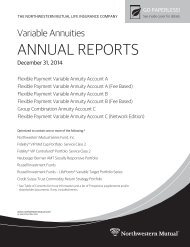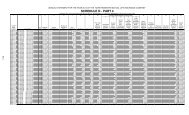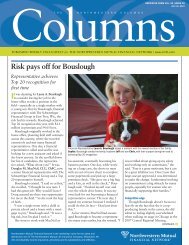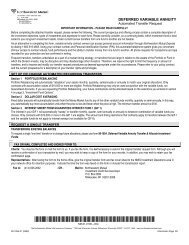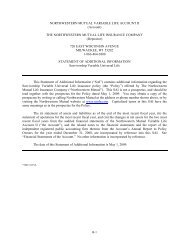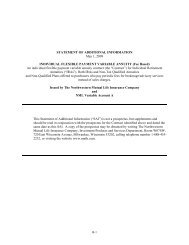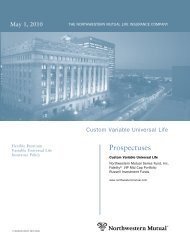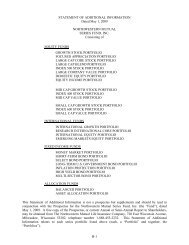include range floaters which are a deposit or a note that accrues interest daily when the underlyingreference point is within a predetermined range and accrues at a below-market rate (normally 0%) whenoutside that range.Inverse floaters are debt instruments whose interest rate bears an inverse relationship to theinterest rate on another instrument or index. For example, upon reset the interest rate payable on asecurity may go down when the underlying index has risen. Certain inverse floaters may have an interestrate reset mechanism that multiplies the effects of change in the underlying index. Such mechanism mayincrease the volatility of the security’s market value. See “Inverse Floaters” below for additionalinformation.There is no guarantee that the use of hybrid instruments will be successful, and a Portfolio couldlose money if, for example, interest rates do not move as anticipated or credit problems develop with theissue of the hybrid instrument. Additionally, the risks of investing in hybrid instruments reflect acombination of the risks of investing in securities, options, futures and currencies, and the underlyingbenchmarks or prices for the underlying assets may be highly volatile and this volatility may be magnifiedstill further by the terms of the hybrid instrument itself. Also, the prices of the hybrid instrument and thebenchmark or underlying asset may not move in the same direction or at the same time. Hybridinstruments may bear interest or pay dividends at below market (or even relatively nominal) rates, or bearinterest at above market rates but bear an increased risk of principal loss (or gain). The latter situationmay result in leverage, meaning that the hybrid instrument is structured such that the risk of loss, as wellas the potential for gain, is magnified. Under certain conditions, the redemption value of such aninstrument could even be zero. Hybrid instruments may also involve greater liquidity risk than other typesof investments; since they are often individually negotiated to meet the portfolio needs of a particularinvestor, the number of other investors that are willing and able to buy such investments in the secondarymarket may be smaller than that for more traditional investments. Hybrid instruments also may not besubject to regulation by federal agencies such as the CFTC and the SEC, which generally regulate thetrading of commodities and securities, respectively.Investment Company Securities And Exchange Traded FundsFrom time to time, the Portfolios may invest in securities of other investment companies, subjectto the provisions of Section 12(d)(1) of the 1940 Act and rules, regulations and exemptive orders issuedby the SEC thereunder. Investment companies may include index based investments such as exchangetraded funds (“ETFs”), which hold substantially all of their assets in securities representing their specificindex. Accordingly, the main risk of investing in index based investments is the same as investing in aportfolio of equity securities comprising the index, although lack of liquidity in an ETF could result in itbeing more volatile. As a shareholder of another investment company, a Portfolio would bear its pro rataportion of the other investment company’s expenses, including advisory fees, in addition to the expensesa Portfolio bears directly in connection with its own operation. The market prices of index basedinvestments will fluctuate in accordance with both changes in the market value of their underlyingportfolio securities and due to supply and demand for the instruments on the exchanges on which they aretraded (which may result in their trading at a discount or premium to their net asset values). Index basedinvestments may not replicate exactly the performance of their specific index because of transaction costsand because of the temporary unavailability of certain component securities of the index.Preferred StocksEach of the Portfolios may invest in preferred stocks. Generally, preferred stock has a specifieddividend and ranks after bonds and before common stocks in its claim on income for dividend paymentsand on assets should the company be liquidated. While most preferred stocks pay a dividend, preferredstock may be purchased where the issuer has omitted, or is in danger of omitting, payment of its dividend.B-32
Convertible SecuritiesEach of the Portfolios may invest convertible securities. A convertible security is a bond,debenture, note, preferred stock or other security that may be converted into or exchanged for a prescribedamount of common stock of the same or a different issuer within a particular time period at a specifiedprice or formula. A convertible security entitles the holder to receive the interest paid or accrued on debtor the dividend paid on preferred stock until the convertible security matures or is redeemed, converted orexchanged. Before conversion or exchange, such securities ordinarily provide a stream of income withgenerally higher yields than common stocks of the same or similar issuers, but lower than the yield onnon-convertible debt. Of course, there can be no assurance of current income because issuers ofconvertible securities may default on their obligations. In addition, there can be no assurance of capitalappreciation because the value of the underlying common stock will fluctuate. Because of the conversionfeature, the managers consider some convertible securities to be equity equivalents.The price of a convertible security will normally fluctuate in some proportion to changes in theprice of the underlying asset. A convertible security is subject to risks relating to the activities of theissuer and/or general market and economic conditions. The stream of income typically paid on aconvertible security may tend to cushion the security against declines in the price of the underlying asset.However, the stream of income causes fluctuations based upon changes in interest rates and the creditquality of the issuer. In general, the value of a convertible security is a function of (1) its yield incomparison with yields of other securities of comparable maturity and quality that do not have aconversion privilege and (2) its worth, at market value, if converted or exchanged into the underlyingcommon stock. The price of a convertible security often reflects such variations in the price of theunderlying common stock in a way that a non-convertible security does not. At any given time,investment value generally depends upon such factors as the general level of interest rates, the yield ofsimilar nonconvertible securities, the financial strength of the issuer and the seniority of the security in theissuer's capital structure.A convertible security may be subject to redemption at the option of the issuer at a predeterminedprice. If a convertible security held by a Portfolio is called for redemption, the Portfolio would berequired to permit the issuer to redeem the security and convert it to underlying common stock or to cash,or would sell the convertible security to a third party, which may have an adverse effect on the Portfolio.A convertible security may feature a put option that permits the holder of the convertible security to sellthat security back to the issuer at a predetermined price. A Portfolio generally invests in convertiblesecurities for their favorable price characteristics and total return potential and normally would notexercise an option to convert unless the security is called or conversion is forced.Unlike a convertible security that is a single security, a synthetic convertible security iscomprised of two distinct securities that together resemble convertible securities in certain respects.Synthetic convertible securities are created by combining non-convertible bonds or preferred stocks withwarrants or stock call options. The options that will form elements of synthetic convertible securities willbe listed on a securities exchange or NASDAQ. The two components of a synthetic convertible security,which will be issued with respect to the same entity generally are not offered as a unit, and may bepurchased and sold by a Portfolio at different times. Synthetic convertible securities differ fromconvertible securities in certain respects. Each component of a synthetic convertible security has aseparate market value and responds differently to market fluctuations. Investing in a synthetic convertiblesecurity involves the risk normally found in holding the securities comprising the synthetic convertiblesecurity.Reverse Convertible NotesThe Portfolios may invest in reverse convertible notes. A reverse convertible is a short-tointermediateterm structured product, generally issued by a financial institution, in which performance isbased on that of an underlying security, commodity or index. Generally, at maturity the note matures atB-33
- Page 4: APPENDIX F - Proxy Voting Policies
- Page 9 and 10: stocks that make up that index. Str
- Page 11 and 12: Interest rate swaps do not involve
- Page 13 and 14: the Adviser or Sub-Adviser will not
- Page 17 and 18: Forward Contracts. The Portfolios m
- Page 19 and 20: principal amount as the call writte
- Page 21 and 22: Options on Foreign Currencies. The
- Page 23 and 24: securities. The issuers of the unde
- Page 25 and 26: the former pools. However, timely p
- Page 27 and 28: CMO residuals are generally purchas
- Page 29: utilize the underlying assets may r
- Page 34 and 35: par unless the price of the underly
- Page 36 and 37: to changes in interest rates genera
- Page 38 and 39: corresponding floaters. The underly
- Page 40 and 41: A Portfolio will not enter into suc
- Page 42 and 43: egulations. The presence of an issu
- Page 44 and 45: Portfolio TurnoverPortfolio turnove
- Page 46 and 47: The ability of the Portfolio to ach
- Page 48 and 49: Advisors, LLC, in accordance with t
- Page 50 and 51: OWNERSHIP OF SHARES OF THE FUNDAll
- Page 52 and 53: on the next $50 million, 0.50% on t
- Page 54 and 55: Independent Registered Public Accou
- Page 56 and 57: Name of Portfolio 2008 2007 2006Int
- Page 58 and 59: Broker High Yield Bond BalancedAsse
- Page 60 and 61: and cost of trade execution of Port
- Page 62 and 63: Effective April 30, 2008, the Fund
- Page 64 and 65: TAXES AND DIVIDENDSEach Portfolio i
- Page 66 and 67: APPENDIX A - Credit RatingsDescript
- Page 68 and 69: F2Good credit quality. A satisfacto
- Page 70 and 71: . Moody’s Commercial Paper (short
- Page 72 and 73: Plus (+) or minus (-)The ratings fr
- Page 74 and 75: APPENDIX B - Directors and Officers
- Page 76 and 77: Name, Address, andYear of BirthDavi
- Page 78 and 79: APPENDIX C - Ownership of Shares of
- Page 80 and 81: SMALL CAP VALUE PORTFOLIOGeneral Ac
- Page 82 and 83:
APPENDIX D - Portfolio ManagersOthe
- Page 84 and 85:
PortfolioManager(s)FundRegisteredIn
- Page 86 and 87:
Compensation of Portfolio ManagersM
- Page 88 and 89:
management firms. Performance is pr
- Page 90 and 91:
Portfolio managers are eligible for
- Page 92 and 93:
PortfolioPortfolio Manager(s)Dollar
- Page 94 and 95:
On August 25, 2005, the Court enter
- Page 96 and 97:
MSA’s Equity Trading Department s
- Page 98 and 99:
ERISA ClientsIn the case of client
- Page 100 and 101:
Shareholder Ability to Call Special
- Page 102 and 103:
• Exercise price• Participation
- Page 104 and 105:
Amend Quorum RequirementsVote propo
- Page 106 and 107:
Vote proposals to increase blank ch
- Page 108 and 109:
employees of Investment Manager and
- Page 110 and 111:
will not support the position of a
- Page 112 and 113:
company specifies the voting, divid
- Page 114 and 115:
egarding whether Investment Manager
- Page 116 and 117:
3. The issuer is an entity particip
- Page 118 and 119:
manager(s) are responsible for maki
- Page 120 and 121:
Global Corporate Governance: Invest
- Page 122 and 123:
13. The Proxy Group will review the
- Page 124 and 125:
determined by those investment comm
- Page 126 and 127:
T. Rowe Price has adopted these Pro
- Page 128 and 129:
shareholders and the effect on shar
- Page 130 and 131:
portfolio company could have influe
- Page 132 and 133:
The Proxy Voting Service will refer
- Page 134 and 135:
that substantially differs from dom
- Page 136 and 137:
15. Janus will generally vote in fa
- Page 138 and 139:
46. For shareholder proposals outsi
- Page 140 and 141:
2. Staggered BoardIf a company has
- Page 142 and 143:
proposed for a legitimate business
- Page 144 and 145:
APPENDIX G - Portfolio Holdings Dis
- Page 146:
ICP Securities LLCIntermonte Securi



